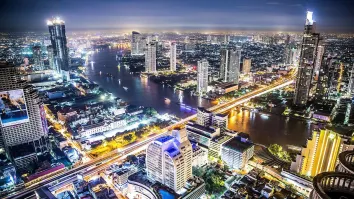Managing the financial risk of aiming for Net Zero
By Kar Wee AngReaching net zero by 2050 doesn’t sound particularly ambitious. It’s thirty years away. But the reality is that reaching net zero by 2050 – as Thailand and Vietnam recently pledged to do – will be an uphill battle for both economies.
And there are Asian countries with steeper hills to climb. Indonesia, which is the world’s biggest exporter of thermal coal, wants its own energy to be fully renewable by 2060. At the minute, coal provides over half of Indonesia’s energy. Weening Indonesian businesses off coal and levying a carbon tax that really bites will involve hard economic choices.
Not everyone agrees the burdens Asia faces are equitable. As the Prime Minister of Vietnam, Pham Minh Chinh, pointed out at the COP26 summit in Glasgow, Vietnam only began industrialisation around 30 years ago, and hence it has not been a major driver of climate change.
But that doesn’t mean countries in the region are immune to climate risk. Nor does it mean they don’t need to reduce their own greenhouse gas emissions. Thailand, for example, is one of the 20 countries most affected by atmospheric degradation.
Tough choices too for banks – and opportunities
The financial sector might appear more sheltered from climate risk than energy firms or manufacturers. The reality, however, is that they are on the front line of climate change, as a recent webinar from the London Institute of Banking & Finance explained. They will have to tackle a new set of risk management requirements as they fund green investment. At the same time, they must manage the risks that climate change poses to their firms.
But going green also offers endless opportunities for longevity. For example, Open Development Thailand says taking a green approach to growth would not only protect Thailand’s natural resources – including mangroves and coral reefs – it would also boost the economy. And it’s estimated that the boost could be as much as 7.8% compared to ‘business as usual’.
Thailand is not alone in that. The consultancy group Bain points out that Southeast Asia “has some of the world’s most valuable investable carbon stock”.
Taxonomies will help find green assets
But how can financial services firms know what investments are green? Thailand, like its neighbours Vietnam, Malaysia and Singapore, is producing a sustainable finance taxonomy. That will help its financial institutions to pinpoint what is green and what is not. It should also encourage investment – both domestic and foreign.
That investment will be needed. Thailand, for example, recently announced that it would pay out nearly US$5 billion to farmers who have been affected by floods, droughts and Covid. Without climate change that payout would, arguably, not have been so high.
Getting the risk/reward balance right
Reaching net zero will mean a lot of work for banks. Consulting firm Oliver Wyman, for example, estimates that around US$50 trillion in investments is needed to transition the global economy to net zero.
Regulators are putting in place rules to get banks to boost green investment and to manage the risks involved. That is both the transition risk and the physical risks that come with climate change.
Transition risks are generated by moving away from unsustainable assets, like investments in fossil fuels, to green investments. Those risks could include struggling to raise capital, or having to divest lucrative assets.
Physical risks to banks come from the challenges that countries like Thailand are already grappling with – the costs incurred by extreme weather events and changes to environment.
What are regulators doing to change the way banks work? The Thai government requires its banks to adopt “robust risk management frameworks that properly monitor, report, and verify ESG risks and opportunities.” Vietnam’s regulator has a similar approach.
The banks themselves also have a say in how risk management will develop. The Thai Bankers Association, for example, is a member of the Sustainable Banking and Finance Network (SBFN), which includes 66 institutions – both banks and regulators – from 44 countries and covers 86% of the total banking assets in emerging markets. Those combined assets are worth US$43 trillion.
The Sustainable Banking and Finance’s latest report looks at its members’ overall progress on implementing ESG risk management, as of July 2021. Not all member countries include ESG risk management responsibilities in their national corporate governance codes, but it’s a growing trend.
The report notes that none of the SBFN members have been able to mainstream ESG practices yet because they don’t have robust data on bank how banks are changing their ESG risk management and performance.
That should be a wakeup call to all bankers in the region: the regulators are coming and they will want to know how you are managing ESG risk.




















 Advertise
Advertise








